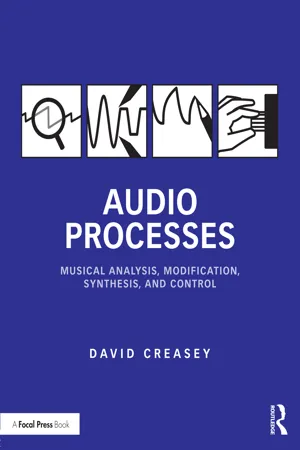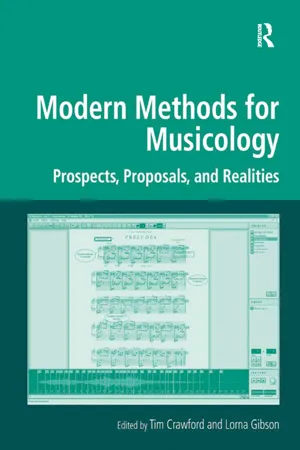Sound Representation
Sound representation refers to the digital encoding of audio signals for storage, transmission, and processing. In computer science, sound representation involves converting analog sound waves into a digital format using techniques such as pulse code modulation (PCM) or other encoding methods. This allows computers to manipulate and play back audio data.
5 Key excerpts on "Sound Representation"
- Ross Kirk, Andy Hunt(Authors)
- 2013(Publication Date)
- Routledge(Publisher)
...Part 2 Sounds and signals The purpose of this section is to understand the nature of the sound signal as it is encountered in digital audio and music technology systems – its structure, genesis and transformation. Parts 2 also deals with the important topic of sampling, and the representation of a signal as a sequence of binary numbers – the basis of digital audio. In essence, this section provides an introduction to signal processing for digital sound systems. No prior knowledge of these topics is assumed on the part of the reader. Chapter 2 describes the nature of the acoustic signal which is manipulated within digital audio and computer music systems. Chapter 3 then considers the way in which the signal is represented and processed in elementary signal processing algorithms. In essence, this section provides an introduction to signal processing for digital sound systems. 2 Sound and signals in music technology and digital audio Overview Digital audio and music technology are concerned with the recording, transmission and manipulation of the acoustic signal within electrical systems. Chapters 1 outlined the experiments of the pioneers of sound processing, and we can see that an understanding of the sound signal is an important first step in following in their work. In order to be able to develop and exploit these processes, it is necessary to understand the nature of the acoustic signal as it is represented in the electrical world, and to recognise the effects which transmission through electrical systems will have on these signals...
- eBook - ePub
Audio Processes
Musical Analysis, Modification, Synthesis, and Control
- David Creasey(Author)
- 2016(Publication Date)
- Routledge(Publisher)
...At present this might appear to have limited use, but this is the basis on which many subsequent ideas are built. 2.2 Sound as Numbers 2.2.1 Overview Acoustic sound waves can be represented accurately by numerical values inside a digital audio system. For example, it is possible to record the output of a microphone into a digital system and then play it back at a later stage in such a manner that there is no significant difference in perceived sound quality There are two particular questions that must concern the audio process engineer: How is an accurate digital representation achieved? What do the numbers mean? The first question is about achieving an effective translation between the acoustic domain and the digital domain (and vice versa). Once that has been achieved, it is not a great step to being able to store and retrieve the audio data. After all, storing and retrieving numerical data is a task at which computers excel. In terms of the second question, being able to achieve a numerical representation of audio does not indicate anything about what it means. There is no explicit information in the translation from acoustic waves to numbers and back again that indicates what instruments are being played, or whether there is any reverberation, or what words are being sung. To construct an audio process that analyses, modifies, or synthesizes digital audio, it is necessary to understand what the patterns of numbers within the stream represent. Chapters 3 and 4 consider that in depth. 2.2.2 Sampling Continuous Data An acoustic waveform is time-continuous; it is an unbroken line, even when zoomed to very small lengths of time (figure 2.9). This would suggest a level of precision that is difficult to match in a digital representation of that signal, but it is not necessarily the case that the very smallest details in a practical continuous signal are of value...
- eBook - ePub
Modern Methods for Musicology
Prospects, Proposals, and Realities
- Tim Crawford, Lorna Gibson, Tim Crawford, Lorna Gibson(Authors)
- 2016(Publication Date)
- Routledge(Publisher)
...Chapter 2 Computer Representation of Music in the Research Environment Geraint A. Wiggins 1. Introduction Music representation systems have been a part of human culture for millennia. The primary purpose of early music representation systems (that is, from ancient times until the beginning of musicology in the eighteenth century) was to record music for the purpose of reproduction by performers other than the composer and/or as aides memoire to the composer. With the advent of academic study of music, music notation became more than performance instructions, providing data for research and teaching. At the end of the nineteenth century, audio recording became possible, supplying a new, much more detailed representation of the musical signal — though it lacked the structural information made explicit in the (modern) score. 1 In the mid-twentieth century, computers were applied to the analysis of both score and audio data, producing a plethora of new data, which then had to be stored. Typically, this data was (and is) produced piecemeal across the world, as the output of many separate projects, and was (and is) often represented for storage in ways which were (and are) not general and therefore not interoperable; 2 nor were (and are) they intended to be so, interoperability not being the aim of the research. In the late 1980s and early 1990s, 3 there were several attempts to produce symbolic representations for music, 4 and some research on the philosophy and underlying mathematics of such representations. 5 However, no conclusive consensus on generally appropriate features for music representation was reached...
- eBook - ePub
Music Technology and the Project Studio
Synthesis and Sampling
- Dan Hosken(Author)
- 2012(Publication Date)
- Routledge(Publisher)
...CHAPTER 1 Sound The focus of this book is the creation of rich, complex timbres using software instruments that employ various synthesis and sampling techniques. The output of these instruments is first carried as digital audio from the software to the audio interface and then as sound from the speakers or headphones to your ears. Sound and digital audio, then, are fundamental topics that underlie the creation of these rich, complex timbres. Both sound and digital audio are deep subjects that would require several books many times the size of this one to fully explain. The goal of these first two chapters is more modest: to provide an overview of essential sound and digital audio concepts necessary to create sounds through synthesis and sampling. The way the material in this book is presented assumes that you have some experience with music technology and thus some understanding of sound and digital audio. As a result, the material in these chapters is presented in a relatively brief fashion to review important concepts and provide a common basis for the terminology that will be used throughout the book. SOUND GENERATION, PROPAGATION, AND PERCEPTION A sound wave can be thought of in three different phases: generation, propagation, and perception. First, a sound wave is generated by a vibrating source, such as a drumhead, a string, buzzing lips, or a speaker cone, that comes in contact with an elastic medium, such as air. The vibrating source creates regions of air pressure that are higher and lower than normal air pressure as the molecules in the air are periodically pushed together...
- eBook - ePub
- David Austerberry(Author)
- 2013(Publication Date)
- Routledge(Publisher)
...The most widely used was pulse-code modulation. PCM The basis of digital audio is pulse-code modulation or PCM. The microphone generates a voltage proportional to the air pressure (or velocity). This is sampled at regular intervals. The sample value is turned into a digital code word. The key parameters of the coding are the sampling rate and the resolution or bit depth. Pre-emphasis is a simple scheme to counteract hiss, or high-frequency noise, in electronic circuits. By boosting the amplitude of high-frequency content, the signal-to-noise ratio can be improved. It has been used in FM broadcasting, and is an option in some digital coding. It relies on there being less energy at high frequencies for typical content. It does trade dynamic range for lower noise, so is not essential to the process of conversion and coding. Figure 6.1 Analog-to-digital conversion. Sampling The sampling rate is set by the desired frequency response. Sampling theory dictates that the sampling frequency should be greater than twice the highest frequency that is to be captured (the Nyquist criteria). The sampling rate is a compromise: the higher the rate, the more sample data is generated. Human hearing extends from 20 to 20,000 Hz, but speech uses a limited range in the center from 500 to 3,000 Hz. For high-fidelity applications, the sampling must be higher than 40 kHz, but a speech channel could use a rate as low as 6 kHz. Resolution The digital coding converts the analog waveform, with essentially a continuum of values, to a number of discrete levels – a process of quantization. The number of levels used determines the resolution. Table 6.1 Main Audio Sampling Rates Sampling rates Frequency response Application 8 kHz 200 Hz–3.3 kHz Telephony 16 kHz 100 Hz–7 kHz Wideband speech 32 kHz 50 Hz–15 kHz Broadcast distribution 44.1 kHz 20 Hz–20 kHz Consumer (CD) 48 kHz 20 Hz–20 kHz Professional and broadcast Max...




